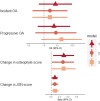Increased development of radiographic hip osteoarthritis in individuals with high bone mass: a prospective cohort study
- PMID: 33407835
- PMCID: PMC7788917
- DOI: 10.1186/s13075-020-02371-0
Increased development of radiographic hip osteoarthritis in individuals with high bone mass: a prospective cohort study
Abstract
Background: Individuals with high bone mass (HBM) have a greater odds of prevalent radiographic hip osteoarthritis (OA), reflecting an association with bone-forming OA sub-phenotypes (e.g. osteophytosis, subchondral sclerosis). As the role of bone mineral density (BMD) in hip OA progression is unclear, we aimed to determine if individuals with HBM have increased incidence and/or progression of bone-forming OA sub-phenotypes.
Methods: We analysed an adult cohort with and without HBM (L1 and/or total hip BMD Z-score > + 3.2) with pelvic radiographs collected at baseline and 8-year follow-up. Sub-phenotypes were graded using the OARSI atlas. Superior/inferior acetabular/femoral osteophyte and medial/superior joint space narrowing (JSN) grades were summed and Δosteophyte and ΔJSN derived. Pain and functional limitations were quantified using the WOMAC questionnaire. Associations between HBM status and change in OA sub-phenotypes were determined using multivariable linear/logistic regression, adjusting for age, sex, height, total body fat mass, follow-up time and baseline sub-phenotype grade. Generalised estimating equations accounted for individual-level clustering.
Results: Of 136 individuals, 62% had HBM at baseline, 72% were female and mean (SD) age was 59 (10) years. HBM was positively associated with both Δosteophytes and ΔJSN (adjusted mean grade differences between individuals with and without HBM βosteophyte = 0.30 [0.01, 0.58], p = 0.019 and βJSN = 0.10 [0.01, 0.18], p = 0.019). Incident subchondral sclerosis was rare. HBM individuals had higher WOMAC hip functional limitation scores (β = 8.3 [0.7, 15.98], p = 0.032).
Conclusions: HBM is associated with the worsening of hip osteophytes and JSN over an average of 8 years, as well as increased hip pain and functional limitation.
Keywords: BMD; High bone mass; Hip osteoarthritis; Progression; WOMAC.
Conflict of interest statement
The authors have no competing interests to disclose.
Figures



Similar articles
-
Individuals with high bone mass have increased progression of radiographic and clinical features of knee osteoarthritis.Osteoarthritis Cartilage. 2020 Sep;28(9):1180-1190. doi: 10.1016/j.joca.2020.03.020. Epub 2020 May 14. Osteoarthritis Cartilage. 2020. PMID: 32417557
-
High bone mass and cam morphology are independently related to hip osteoarthritis: findings from the High Bone Mass cohort.BMC Musculoskelet Disord. 2022 Aug 6;23(1):757. doi: 10.1186/s12891-022-05603-3. BMC Musculoskelet Disord. 2022. PMID: 35933372 Free PMC article.
-
Prevalence of radiographic hip osteoarthritis is increased in high bone mass.Osteoarthritis Cartilage. 2014 Aug;22(8):1120-8. doi: 10.1016/j.joca.2014.06.007. Epub 2014 Jun 24. Osteoarthritis Cartilage. 2014. PMID: 24971870 Free PMC article.
-
Individuals with high bone mass have an increased prevalence of radiographic knee osteoarthritis.Bone. 2015 Feb;71:171-9. doi: 10.1016/j.bone.2014.10.015. Epub 2014 Oct 30. Bone. 2015. PMID: 25445455 Free PMC article.
-
Osteoarthritis: Insights Offered by the Study of Bone Mass Genetics.Curr Osteoporos Rep. 2021 Apr;19(2):115-122. doi: 10.1007/s11914-021-00655-1. Epub 2021 Feb 4. Curr Osteoporos Rep. 2021. PMID: 33538965 Free PMC article. Review.
Cited by
-
Relationship between knee pain and depth-specific measures of proximal tibial subchondral bone density.Osteoarthritis Cartilage. 2025 May;33(5):625-632. doi: 10.1016/j.joca.2025.02.781. Epub 2025 Mar 13. Osteoarthritis Cartilage. 2025. PMID: 40089263
-
Spatial assessment of femoral neck bone density and microstructure in hip osteoarthritis.Bone Rep. 2021 Dec 9;16:101155. doi: 10.1016/j.bonr.2021.101155. eCollection 2022 Jun. Bone Rep. 2021. PMID: 34984214 Free PMC article.
-
Three-Dimensional Reconstruction of Computed Tomography Imaging Is Not Reliable in Assessing Acetabular Rim Osteophytes or Acetabular Rim Pathology in Patients With Femoroacetabular Impingement.Arthrosc Sports Med Rehabil. 2024 Feb 9;6(2):100892. doi: 10.1016/j.asmr.2024.100892. eCollection 2024 Apr. Arthrosc Sports Med Rehabil. 2024. PMID: 38362483 Free PMC article.
-
The Impact of Major and Trace Elements in Serum and Bone on Dual-Energy X-Ray Absorptiometry-Derived Hip Strength.Calcif Tissue Int. 2022 Jun;110(6):674-684. doi: 10.1007/s00223-022-00945-5. Epub 2022 Jan 24. Calcif Tissue Int. 2022. PMID: 35072733 Free PMC article.
-
Application Effect of Cluster-Based Care in Patients with Hypertensive Disorders of Pregnancy and Osteoarthritis.Comput Math Methods Med. 2022 Aug 4;2022:2954330. doi: 10.1155/2022/2954330. eCollection 2022. Comput Math Methods Med. 2022. Retraction in: Comput Math Methods Med. 2023 Sep 27;2023:9891820. doi: 10.1155/2023/9891820. PMID: 35966246 Free PMC article. Retracted.
References
-
- Stewart A, Black A, Robins SP, Reid DM. Bone density and bone turnover in patients with osteoarthritis and osteoporosis. J Rheumatol. 1999;26(3):622–626. - PubMed
Publication types
MeSH terms
Grants and funding
LinkOut - more resources
Full Text Sources
Other Literature Sources
Research Materials

